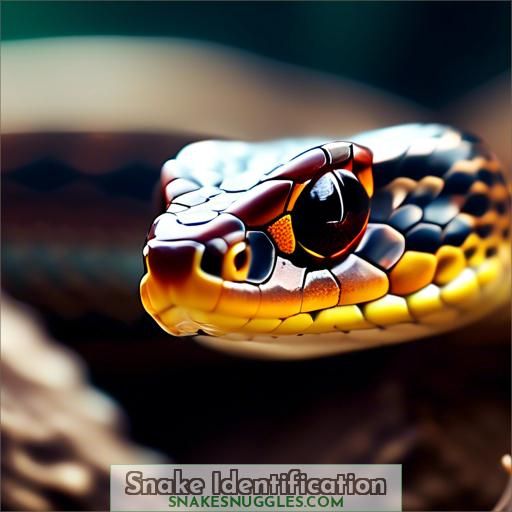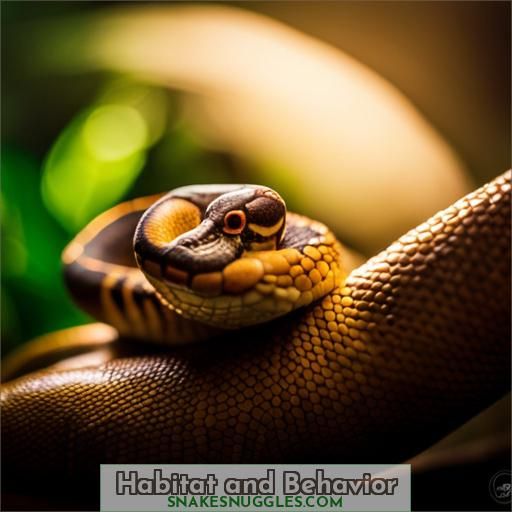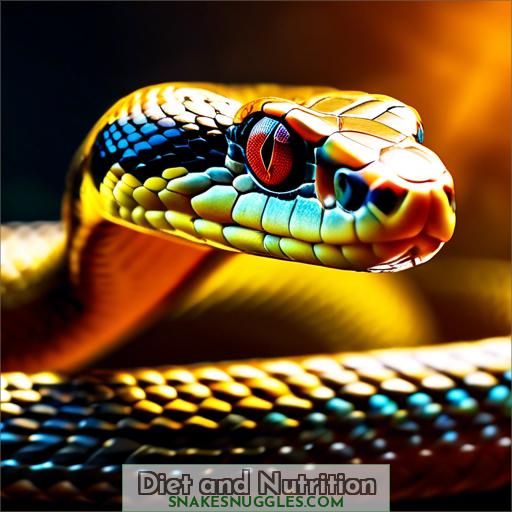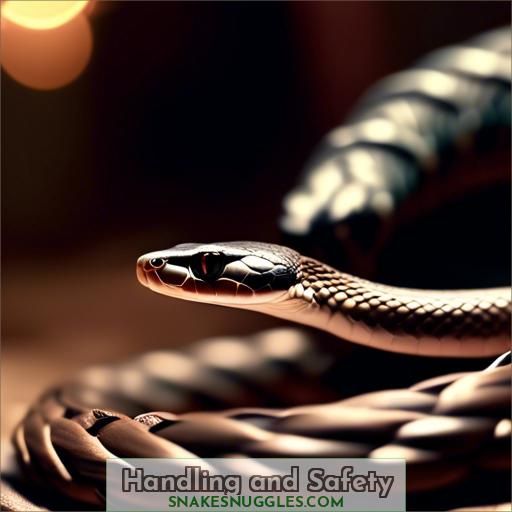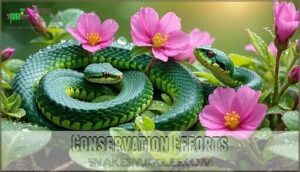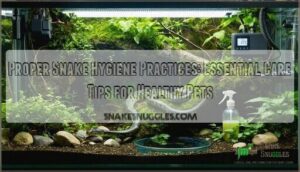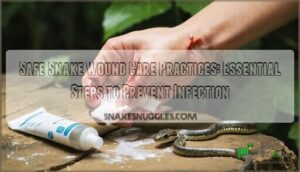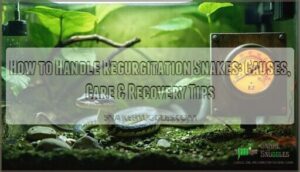This site is supported by our readers. We may earn a commission, at no cost to you, if you purchase through links.

You may encounter small snakes lurking beneath mulch or leaf litter in your garden.
These secretive creatures, often smooth earth snakes with glossy scales and pronounced eyes, prefer loose soil habitats like flower beds for hunting insects and slugs.
Garter snakes are beneficial omnivores that consume pests and even fruits.
Handling smooth species gently can be safe for supervised children, but exercise caution with unfamiliar snakes.
Support conservation by creating snake-friendly spaces.
Understanding their roles allows peaceful coexistence, and further exploration reveals fascinating insights into their world.
Table Of Contents
Key Takeaways
- Small snakes, such as smooth earth snakes, are beneficial for gardens as they consume pests and contribute to ecological diversity.
- Their habitat and behavior include loose soil habitats, burrowing rapidly through the earth, and hunting for slugs and other small prey.
- Gardening practices can impact snake presence, with tidy gardens and avoiding potential hiding spots being recommended for coexistence.
- Conservation efforts focus on protecting snake habitats and educating the public about their importance in the ecosystem.
Snake Identification
When you’re sizing up a slithery visitor in your garden, pay close attention to the clues they offer.
Small snakes, like North Carolina’s earth snakes, often reveal their identity through their scale texture – smooth and glossy for some, like the unassuming brown snake.
Eye size can be telling too; it’s all about the peepers for earth snakes, larger and more pronounced than their burrowing cousins.
And don’t overlook head shape; a small, pointed head might just indicate a master burrower in your midst.
Habitat and Behavior
The diminutive snakes you might encounter in your backyard garden often make their homes in the loose soil of flower beds, burrowing rapidly through the earth with their pointed heads and smooth, shiny scales snake identification. These secretive serpents also lurk beneath mulch layers or leaf litter, their glossy bodies perfectly camouflaged as they hunt for slugs and other small prey.
Flower Beds
Flower beds are a common habitat for various snake species, including worm snakes, earth snakes, and garter snakes. These snakes are often found in gardens and landscapes, where they feed on insects, slugs, and other small invertebrates that can be abundant in these environments. The appearance of these snakes can vary, with some species having smooth, shiny scales and reduced eyes, while others have larger eyes and glossy bodies in dark or pale gray with dark spots.
In terms of soil preferences, worm snakes and earth snakes are known to burrow rapidly through loose soil, making them well-adapted to flower beds and other disturbed habitats. Earthworms and other small invertebrates are important components of their diet, and these snakes can play a beneficial role in controlling pest populations in gardens.
Coexistence methods for snakes in flower beds include leaving them alone and avoiding interactions, as most snake bites occur when people try to handle or harass snakes. It’s also recommended to educate children about snakes and their importance in the ecosystem, as well as to provide them with opportunities to learn about snakes through programs at local nature centers and educational venues.
Mulch and Soil
Mulch and soil are fundamental components of a garden ecosystem, but they can also be the preferred habitat for various snake species. Comprehending the significance of these elements in snake behavior is vital for practical pest management and coexistence with these reptiles.
Mulch use is a widespread practice in gardening, providing numerous advantages such as weed suppression, moisture retention, and temperature regulation. However, it’s essential to be aware of the potential for snake attraction and implement preventative strategies in mulching practices. Some mulch types, like straw and wood chips, are less appealing to snakes due to their less dense nature, making them less hospitable for hiding.
Soil conditions play a significant role in snake habitat. Snakes often seek refuge that protects them from predators and extreme temperatures. Gardens with rocks, crevices, or piles of wood and debris serve as excellent hiding spots. The soil’s moisture content and nutrient levels can also influence snake behavior. For example, snakes native to Africa, like the Sansevieria trifasciata (snake plant), prefer dry conditions and can suffer from root rot in heavy soils that retain moisture.
Gardening practices can impact snake presence. Regularly cleaning up fallen leaves, trimming overgrown bushes, and keeping the grass short can eliminate potential hiding spots for snakes. Additionally, maintaining a tidy garden can enhance overall aesthetics and reduce the likelihood of snakes taking residence.
In terms of pest control, the presence of snakes can be beneficial, as they consume rodents and other small animals that may damage gardens. However, if snakes become a nuisance or pose a danger to human safety, it’s essential to employ effective control methods. These may include exclusion of snakes from structures, habitat change, and searching and killing snakes in specific situations.
Woodlands and Creeks
In the woodlands and creeks of North Carolina, you may encounter a variety of snake species. Here are three snakes that are commonly found in these habitats:
- Red-bellied Snakes: These small, docile snakes are most abundant in deciduous and mixed woodlands, where they prefer a damp, moist, and cool environment. They’re often found around human habitations and can be seen basking in the open sun or climbing into low shrubs and other vegetation.
- Southeastern Crowned Snakes: These snakes are often found in woodlands adjacent to wetlands, such as creeks or moist woodlands. They feed on small prey, including termites, worms, centipedes, spiders, and earth-dwelling insect larvae.
- Black Swampsnakes: These small, thin water snakes are almost entirely aquatic and can be found in woodlands near wet areas with dense vegetation. They’re rarely seen on dry land and deliver their live babies directly in shallow water.
These snakes play an important role in the ecosystem by controlling populations of other pests, such as rodents and insects, and are an important food source for animals like hawks, owls, and raccoons.
Diet and Nutrition
You may be surprised to learn that garter snakes, often found in backyard settings, have specific dietary needs.
These needs can be met through innovative solutions like Reptilinks micro links.
These nutrient-dense, worm-like pieces fulfill the garter snake’s natural feeding instincts.
They simultaneously provide a balanced diet, ensuring the snake’s health and well-being, especially when supplemented with an occasional pinky mouse.
Similarly, corn snakes flourish on a diet of appropriately sized Reptilink quail or rabbit links.
This diet contributes to their glossy appearance and perfect sheds.
Garter Snakes
Garter snakes are a common sight in many backyards.
They are omnivores, consuming a variety of prey such as earthworms, slugs, and small rodents.
They also eat fruits and vegetables, making them a beneficial addition to gardens.
Garter snakes reproduce annually, with females laying eggs in the spring.
They can live up to 20 years and play an important role in pest control.
Conservation efforts focus on protecting their habitats, which include wetlands and moist woodlands.
Corn Snakes
In the wild, a corn snake’s habitat shapes its behavior and diet, making it a master of adaptation. These slithery detectives thrive on a nutrition-rich menu of rodents, demonstrating nature’s balance. Embrace their presence as a sign of a healthy, pest-controlled garden.
Reptilinks
Discover the nutritional advantages of Reptilinks for your garter snakes.
These worm-like links are eagerly accepted by garters and provide a more nutritious option than earthworms.
Reptilinks come in small pieces, making them ideal for garter snakes.
Unscented links are also available for immediate acceptance by your pets.
Integrate Reptilinks into your feeding methods to ensure your garters are healthy and thriving.
Handling and Safety
You can gently handle smooth earth snakes, as they’re inoffensive and suitable for children to interact with under supervision. However, exercise caution when encountering other small snake species, as some may be venomous and require expert handling to avoid potential bites or injury.
Smooth Earth Snakes
Smooth earth snakes, like their worm snake counterparts, are often found in flower beds and gardens.
They are suitable for gentle handling by children due to their small size and inoffensive nature.
However, it is essential to remember that all snakes should be treated with respect and care.
While they may share similarities with worm snakes, smooth earth snakes have larger eyes and a glossier body coloration.
Their habitat preferences include loose soil and mulch, making them a beneficial addition to any garden as they consume slugs.
Venomous Species
Snakes are captivating creatures, but it’s essential to be conscious of the poisonous species that might dwell in your vicinity. Here are three key tactics to help avert snakebites and guarantee safety:
- Be aware of your surroundings: Always be mindful of your surroundings, particularly in areas where snakes are known to reside. Avoid specific snake habitats like brush piles, debris mounds, logjams, root systems, abandoned buildings, and watery areas.
- Wear appropriate footwear: Wear leather shoes or boots that cover your ankles when walking in snake-prone areas. This can help protect you from potential snakebites.
- Learn basic snakebite first aid: In the event of a snakebite, remain composed and immobilize the affected limb. Keep it at a level below the heart and minimize total body activity as much as possible. Seek medical attention immediately.
Additionally, it’s worth noting that antivenom is accessible for some poisonous snakebites, but it can be costly and might necessitate specialized medical knowledge for administration. In some cases, venom effects can be grave, leading to loss of limbs, paralysis, or even death.
To minimize the risk of encountering poisonous snakes, consider habitat modification techniques such as sealing potential entry points and removing attractants like food and water sources. These measures can help discourage snakes from entering your property.
Conservation Efforts
As a responsible pet owner, you can contribute to the conservation of snake species by supporting local and national conservation organizations.
These groups work tirelessly to restore habitats, educate the public, and advocate for legal protections.
By participating in citizen science projects, you can help track and monitor snake populations, providing valuable data for conservation efforts.
Additionally, you can create a safe and welcoming environment for snakes in your own backyard by providing suitable habitats and avoiding the use of pesticides.
Frequently Asked Questions (FAQs)
How do small snakes reproduce?
Picture a serpentine dance, an intricate ritual of twisting coils, as tiny snakes engage in a passionate embrace. Their secret lies in the gentle caress of scales, exchanging life’s essence to create anew.
What are the common predators of small snakes?
Birds, mammals, and larger snakes are common predators you should watch out for. Some even prey on snake eggs and hatchlings, so secure your enclosure properly.
Can small snakes recognize their owners?
Like tiny, scaly sages, small snakes absolutely can recognize their caring human companions through scent and routine. With time and gentleness, an unbreakable bond forms between reptile and handler.
How do weather changes affect small snakes?
Weather changes hugely impact small snakes’ activity levels. Cooler temps make ’em sluggish – they’ll likely brumate (snake hibernation). But warmth gets their engines revvin’! They’ll hunt more, bask, and maybe even look for mates if conditions are ideal.
What are the signs of illness in small snakes?
You’ll notice your scaly friend‘s a bit sluggish, off food, has a dull appearance, or wheezy breathing – a snake’s cry for help. Don’t fret; attentive care guarantees their swift recovery.
Conclusion
Consider discovering a tiny serpent curled beneath your garden mulch. Instead of responding with trepidation, you’ve become aware of their crucial functions as vermin regulators and contributors to ecological diversity. By creating welcoming environments and practicing cautious coexistence, you can cultivate a balanced connection with these intriguing little serpents that adorn your backyard ecosystem.

